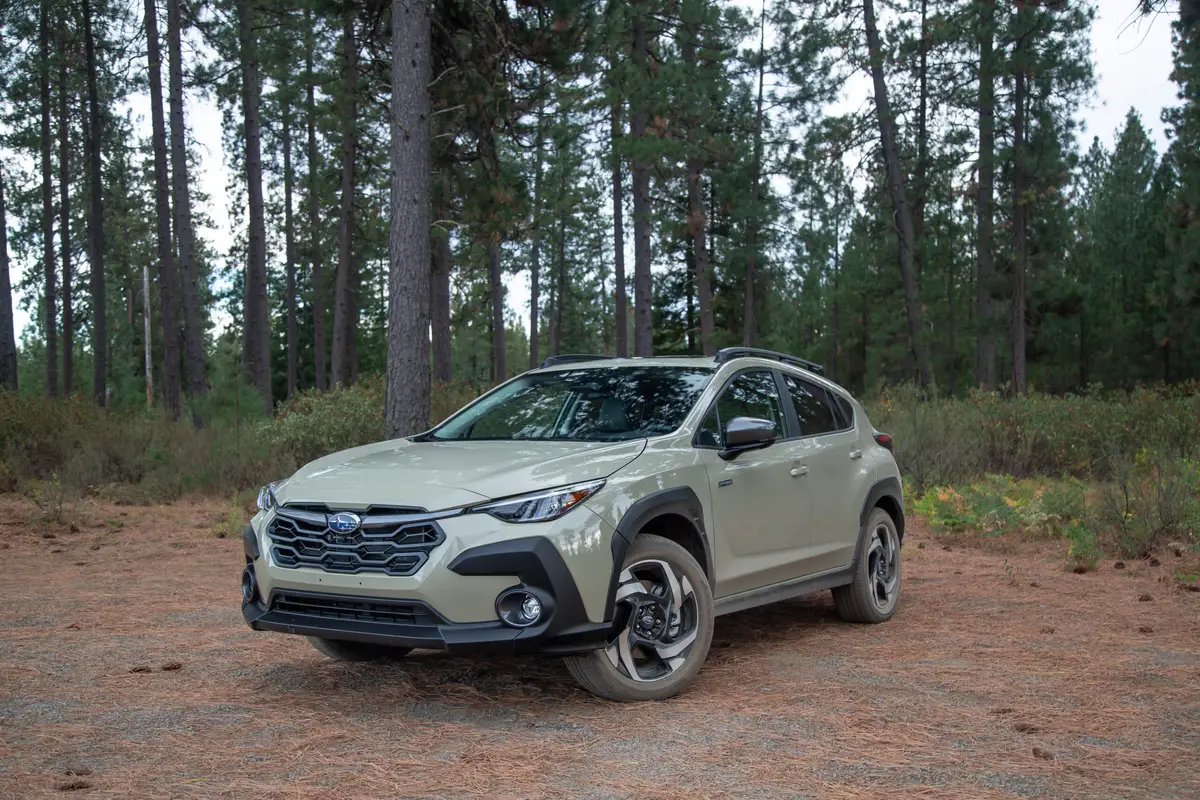What Car Buyers Need to Know About Trump’s New Tariffs Going Into Effect This Month


Editor’s note: This story was last updated April 9, 2025, to include additional tariff updates. Read more on the latest information on tariffs on all imported vehicles and vehicle parts, or see a more detailed explanation of how the tariffs will affect consumers.
On Wednesday, April 2, President Donald Trump announced the implementation of 25% tariffs on all automotive imports as well as what he calls “reciprocal tariffs” on all imports, both of which went into effect in early April. Additionally, Trump signed a second executive order revoking a tariff exemption for low-value imports from China. No car sold in the U.S. is made without some foreign-made components, so here’s what it means for car shoppers.
Related: How Trump’s 25% Tariffs on Automobiles, Automotive Parts Will Affect You
Trump’s “Liberation Day” announcement on April 2 was all about tariffs — specifically, sweeping tariffs on all foreign goods meant to encourage companies to make more products for the American market in the U.S. and generate revenue from imported goods. We’ve previously covered how these also come with negative effects for consumers, as tariffs are taxes applied to imports at the border and are paid by the person or company importing them, and this extra cost of importing goods often gets passed on to consumers.
How Will the Finalized 25% Automotive Tariff Work?
Trump previously announced a 25% tariff on all automotive imports and automotive parts on March 26 and confirmed on April 2 that the tariffs would go into effect at midnight on April 3. You can read our full explainer here of how these will work, but there are key exceptions for automotive imports that comply with the existing U.S.-Mexico-Canada Agreement governing trade with our two neighboring countries.
Companies are unlikely to absorb these tariffs’ costs and are likely to pass along at least some of the extra import costs to consumers in the form of higher prices on cars and parts. A recent analysis by the Anderson Economic Group think tank estimated that the least affected cars — likely ones that are assembled in the U.S. that contain a high amount of U.S. parts content — could see a bump in price of $2,500 to $5,000, while the most affected imported models could jump in price by as much as $20,000.
There was one silver lining to today’s announcement, however: These automotive imports, as well as steel and aluminum imports that are already subject to another tariff Trump instated on Feb. 10, are exempt from the reciprocal tariffs that went into effect on April 5.
What Are Reciprocal Tariffs?
The White House’s official position is that other countries’ trade barriers (such as tariffs on American-made goods, value-added taxes on imported goods, and the manufacture and sale of counterfeit goods) need to be retaliated against on national security grounds. The executive order establishing these retaliatory reciprocal tariffs called the existence of other countries’ trade barriers a national emergency, invoking the International Emergency Economic Powers Act of 1977 as basis for the new tariffs’ implementation.
These reciprocal tariffs are meant as a countermeasure to foreign nations’ trade barriers against the United States and vary from country to country. The baseline rate for all imports is now 10%, with certain countries and trade blocs having higher tariffs. Per the executive order, the baseline 10% tariff went into effect on April 5, while the higher reciprocal tariffs went into effect on April 9. The White House released a chart enumerating specific countries’ rates, which initially included:
- China: 34%
- European Union: 20%
- Japan: 24%
- South Korea: 25%
- United Kingdom: 10%
However, Trump announced on April 9 that he would back off from these higher reciprocal tariffs for 90 days for most countries, charging them only the 10% baseline rate during this time. In a post on social media, Trump claimed that “more than 75 countries” had reached out to negotiate trade deals with the U.S. following the reciprocal-tariff announcement made the prior week. However, Treasury Secretary Scott Bessent confirmed in a press conference that the separate automotive, steel and aluminum tariff rates that were exempt from the reciprocal tariffs will remain in place.
China will not be one of those countries that gets a lower reciprocal tariff, however, as it answered Trump’s 34% tariff with a 34% tariff of its own on U.S. imports into China. This prompted the Trump administration to impose a 50% tariff on top of that, which China answered by adding 50% onto its retaliatory tariff. In Trump’s April 9 announcement of the 90-day reprieve, he expressed displeasure at China’s increasing retaliatory trade measures and announced an increase on the tariffs on Chinese imports to the U.S. — which had grown to a cumulative 104% for most goods — to 125%, also effective immediately.
Notably exempt from the reciprocal tariffs are Canada and Mexico, whose previously implemented 25% tariff still applies, with its separate rules for USMCA-compliant goods and certain energy imports. However, the Trump administration clarified that if this tariff is discontinued, Canada and Mexico would be subject to a 12% tariff instead.
Despite the exemption for automotive parts, these tariffs will make many other imports used by automotive companies more expensive, such as office or manufacturing equipment. Unfortunately, every added cost to a company’s bottom line makes it harder to turn a profit and increases the likelihood of extra tariff costs getting passed on to consumers.
Will Used Cars Also Be Affected?
Older cars — including the one currently sitting in your driveway — may also feel the heat, not only from new 25% tariffs going into effect on auto parts, but in particular if they need a part that’s made in China. Trump’s other executive order revoked the de minimis exemption from tariffs for packages under $800 from China, which will also affect the price of some imported car parts. This revocation does not have an exemption for automotive parts, so expect tariffs to now apply to smaller parts orders that come directly from China. It was previously put on hold on Feb. 7, after the sheer number of these imports (which include packages from low-cost retailers such as Shein and Temu) caused gridlock at the border.
Will Consumers See Any Relief?
With tariffs getting applied then delayed, revised or revoked, some wonder how long these tariffs might stick around. As with previous tariff announcements, countries affected have been swift to threaten their own retaliatory measures, or at least vow to negotiate with the Trump administration. As shown in our running timeline of Trump’s tariffs, one thing is clear: Retaliatory trade threats have worked before in getting the Trump administration to back down on tariffs.
Some pushback on tariffs is coming from inside the country as well: Senate Democrats introduced a resolution to revoke the national emergency that Trump invoked to instate tariffs on Canadian imports, reports the Associated Press. It will face an uphill battle to pass as Democrats are the minority party in both houses of Congress and would need some Republicans — who have mostly backed the Trump administration’s policies — to support the measure for it to pass.
There is one potential source of relief from the Trump administration, however. During the April 2 announcement, Trump reiterated his desire to see a tax deduction for interest paid on the purchase of American-made cars. This does come with some caveats, however, as it wouldn’t offer any relief to buyers who don’t finance their vehicle purchase or the majority of American taxpayers who take a standard tax deduction instead of itemizing out individual deductions. So, it may not help the majority of car shoppers after all unless other parts of the tax code are amended. Ultimately, it’s Congress who will have to finalize any tax-related measures.
More From Cars.com:
- What Do the New Tariffs Mean for Car Buyers?
- Which Cars Are Made Outside the U.S.?
- Which Tariffs Could Affect Your Next Car?
- Thinking About Getting an EV Before the Tax Credit Changes?
- Tariffs on Mexican, Canadian and Chinese Goods Could Affect These Cars the Most
- 2024 Cars.com American-Made Index: Which Cars Are the Most American?
Related Video:
Cars.com’s Editorial department is your source for automotive news and reviews. In line with Cars.com’s long-standing ethics policy, editors and reviewers don’t accept gifts or free trips from automakers. The Editorial department is independent of Cars.com’s advertising, sales and sponsored content departments.

News Editor Stef Schrader joined Cars.com in 2024 but began her career in automotive journalism in 2013. She currently has a Porsche 944 and Volkswagen 411 that are racecars and a Mitsubishi Lancer GTS that isn’t a racecar (but sometimes goes on track anyway). Ask her about Fisher-Price Puffalumps.
Featured stories





